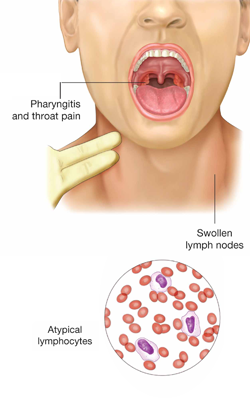
An acute self- limiting infection normally seen among non- immune young adults. The causative agent is the Epstein- Barr (EB) virus. It is found almost anywhere and everywhere among the human population.
Infection with the EB virus leads to latency, periodic reactivation and lifelong persistence. The source of infection is usually saliva of the infected persons. They shed the virus through the oropharyngeal secretions for months.
Intimate oral contact, as in kissing, appears to be the predominant mode of transmission. This gives the disease another name, “the kissing disease”. Infection may also follow blood or marrow transfusion, but are rare events.
The EB virus infection may lead to the following clinical conditions;
1. Infectious mononucleosis
2. EBV associated malignancies like;
a. Burkitt’s lymphoma
b. Lymphomas in immunodeficient persons such as AIDS patients and transplant recipients
c. Nasopharyngeal carcinoma
In case of glandular fever, the incubation period is 4- 8 weeks. The disease is characterized by;
1. Fever
2. Sore throat with inflamed tonsils
3. Serene jaundice
4. Lymphadenopathy (swollen lymph nodes)
5. Presence of of abnormal lymphocytes in peripheral blood smears
6. Excessive tiredness
7. Headache
8. Pain in the abdomen
9. Nausea
10. Vomiting
11. Puffed-up glands in the neck area
12. Cherry to plum colored spots in the top region of the mouth
A mild, transient rash may be present. There is often associated hepatitis. Along with this, a series of complications, including hematological, neurological, cardiac and pulmonary conditions may be present. Splenic rupture may also crop up.
Spontaneous resolution of the disease may occur in 2 – 4 weeks. This may get prolonged leading to mental and physical fatigue. Secondary bacterial infections like pneumonia may follow.
The patient remains infective for about 2 months. They may even carry the virus in the saliva for about 18 months after the infection.
Lab diagnosis is made by the examination of blood. The standard diagnostic procedure is the Paul – Bunnell test. The simple slide agglutination test can also be employed.
Tests are also available for the demonstration of specific EB virus antibodies. Immunofluorescence and ELISA are commonly employed.
Swallowing difficulty and pain in the abdomen are common symptoms, which should be consulted to doctor immediately. Since profoundly effective antiviral drugs are presently unavailable, medicines to manage fever are usually prescribed.
Fever and pain reducing medicines are prescribed for infected ones. Distended tonsils and painful pharyngeal areas can be pacified by corticosteroids, which acts as anti inflammatory.
Hydrocortisone is helpful in cases of blockage of the airways. An antiviral drug, valacyclovir has revealed to lessen the occurrence of the virus, thereby reducing the intensity of the symptoms. These antiviral drugs also help to manage other associated conditions like meningitis, hepatitis, etc.
Several antibiotics are prescribed which is used to treat secondary bacterial infections like pneumonia and throat infections caused by Streptococcus.
Heavy straining works should be avoided, as the spleen will be damaged due to heightened infection. Contact with the saliva of infected ones should be strictly avoided. Hands should be washed properly. The drinking and eating utensils used by the patients should not be shared.





